Effective Strategies to Eliminate Voles from Your Yard
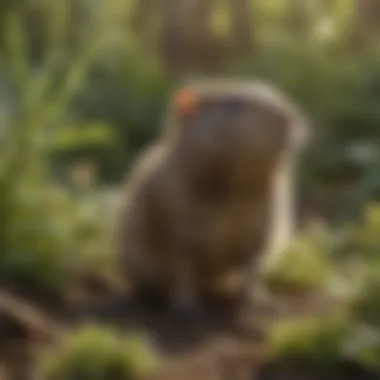
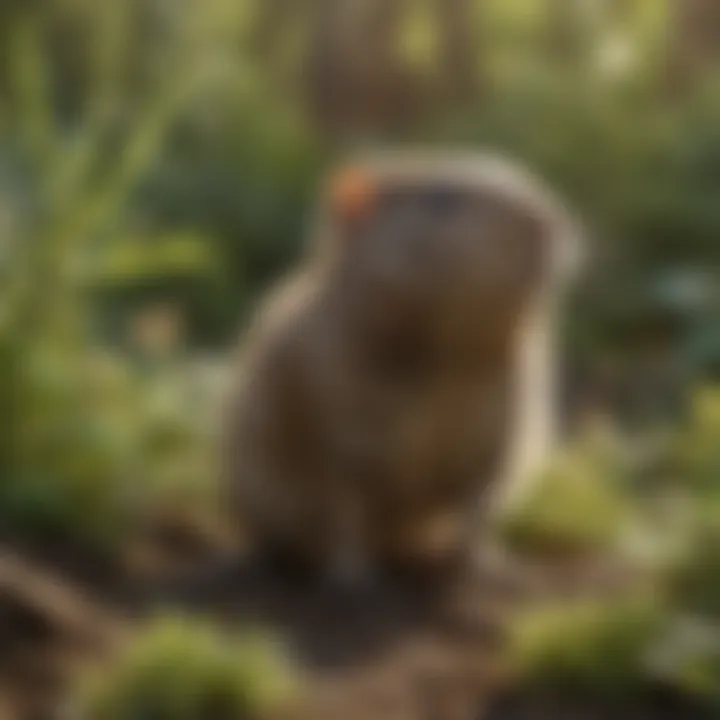
Intro
Voles are small rodents that can pose significant challenges to homeowners. Understanding these pests is crucial for effectively managing their numbers. This article delves into best practices for identifying, preventing, and treating vole infestations in your yard. Whether you are striving to protect your garden or maintain the integrity of your landscape, knowing how voles behave and how to counter their impact is essential.
Pest Identification
Identifying voles in your yard is the first vital step in controlling their population. Voles are often mistaken for other small rodents, such as mice or rats, but they have distinct characteristics.
Detailed Descriptions of Common Pests
Voles, specifically the meadow vole and the pine vole, tend to inhabit grassy and wooded areas. The meadow vole has a stocky body, averaging about 5 to 7 inches in length. Its fur is grayish-brown, often with a lighter underbelly. In contrast, the pine vole is slightly smaller, with a more reserved lifestyle spent underground. Their fur is similar, though they often have darker and shiner coats.
Signs and Symptoms of Infestations
Being aware of signs of vole activity can save you from further damage to your yard. Look for:
- Surface Tunnels: Voles create extensive tunnel systems in grassy areas.
- Gnawed Vegetation: Cut plants at an angle can indicate vole feeding.
- Droppings: Small, cylindrical droppings scattered in gardens.
- Burrowing: Holes roughly 1–2 inches in diameter, often around roots and underground.
Voles can cause extensive damage to gardens, eating roots, bulbs, and even tender bark.
Prevention Strategies
To keep voles at bay, preventive strategies can enhance your yard’s defenses against these rodents. Here are some methods for effective control:
Home Maintenance Tips for Pest Prevention
- Clear Debris: Removing leaf litter and tall grasses creates less habitat.
- Trim Vegetation: Keep shrubs and plants well-maintained to reduce cover for voles.
- Understand Your Yard: Knowing vulnerable areas helps in effectively applying preventive measures.
Natural Deterrents and Barriers
You may utilize various natural deterrents to discourage vole presence:
- Plant Repellents: Certain plants like marigolds can deter voles.
- Physical Barriers: Install hardware cloth around vulnerable plants to shield them from gnawing.
- Noise Makers: Using wind chimes or similar items can create an unwelcome environment for voles.
Treatment Options
Once you identify an infestation, you must develop a control plan. Here’s an overview of various treatment methods:
Overview of Chemical vs. Natural Treatments
There are distinct benefits and drawbacks to both chemical and natural treatments. Chemical treatments are usually faster-acting but may carry risks to local wildlife. Natural treatments tend to be safer, but they may take longer to see results.
Step-by-Step Guides for DIY Treatments
- Traps: Setting snap traps in areas with high activity can be effective. Place them near burrows for optimal impact.
- Bait Stations: Utilize bait stations using grain-based rodenticides. Ensure they are secured to avoid exposure to non-target species.
- Habitat Modification: Reducing shelter can dissuade voles from nesting.
By adopting these strategies, homeowners can effectively manage and minimize potential vole damage, preserving the health of their gardens and landscapes.
Understanding Voles
Understanding voles is one key step in developing effective strategies for their elimination. Voles are small rodents that can cause significant damage to yards and gardens. This background knowledge allows homeowners to identify the species present and their behaviors. An informed approach increases the chances of successful management and reduces damage.
Vole Species Overview
There are several species of voles, but the most common ones found in home gardens include the meadow vole, pine vole, and prairie vole. The meadow vole tends to be more social, often seen in larger groups. They inhabit open areas and prefer grasses. The pine vole, on the other hand, is more solitary and prefers to dig underground tunnels. Prairie voles find a balance between the two, showcasing social behaviors in certain seasons.
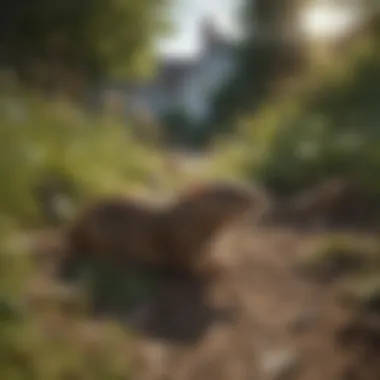
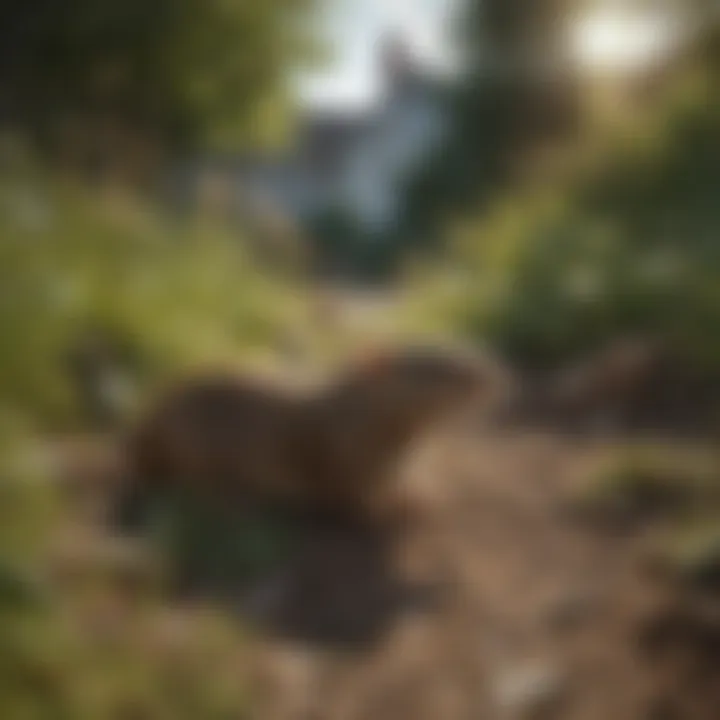
Identifying the specific type of vole can give insight into their behaviors and preferences. For example, if you notice fresh tunnels in your yard, it may be a sign of meadow voles at work. Conversely, if there are more hidden tracks and small holes in the soil, this often indicates the presence of pine voles.
Physical Characteristics
Voles have distinctive physical traits. They are usually smaller than rats but have stockier bodies and shorter tails. Their fur is typically brown or grayish, which allows them to blend into their surroundings. An average adult voley can grow to about 5-7 inches long, not including the tail, which is about 2 inches. Their eyes are small, and they have relatively large front teeth, essential for gnawing on various materials including plant matter. Recognizing these characteristics can assist individuals in differentiating voles from other rodents such as mice or rats.
Behavior and Habitats
Voles are primarily herbivores, feeding on grasses, roots, and seeds. Their feeding habits lead them to form intricate tunnel systems in search of food. They can cause extensive damage to lawns and landscapes in a short time. Voles prefer habitats that offer cover, like thick vegetation or mulch, which they use to hide from predators.
These rodents are most active during dawn and dusk, making them relatively elusive. Homeowners may not always see them, but their presence becomes evident through the signs they leave behind, such as the aforementioned tunnels and damage to plants. Understanding these behaviors helps in planning your control strategies effectively.
"Recognizing and understanding voles in your yard is crucial for implementing effective management strategies."
By deepening your understanding of voles, you arm yourself with the knowledge necessary to tackle their presence efficiently. This foundation sets the stage for recognizing signs of infestation and implementing appropriate removal and preventive measures.
Identifying Signs of Vole Infestation
Recognizing the signs of a vole infestation is essential for effective management. Homeowners often overlook these signs until damage has occurred. By understanding what to look for, you can take action before voles cause significant harm to your property. Early identification allows for quicker intervention and reduces the costs associated with repairs and control methods.
Common Signs
Tunnels and Runways
One of the most obvious indicators of voles is the presence of tunnels and runways. These are small, well-defined paths formed as voles travel between their burrows and feeding areas. Tunnels are typically just below the surface of the soil, making them less visible but still significant. The presence of such pathways indicates that voles are using your yard as a habitat.
The key characteristic of tunnels and runways is their structure. Voles tend to create a network that can lead you directly to their nests. This feature is beneficial because it provides insight into their movement patterns, which can inform your trapping or baiting strategies. It also helps you understand which areas of your yard are most at risk for damage.
Advantages of observing tunnels include the ability to pinpoint vole activity and the ease with which you can set traps at strategic locations. However, one should consider that these signs may not always be clear if the infestation is not severe, making it essential to monitor your yard regularly.
Damage to Plants
Another significant sign of voles is the damage they do to plants and gardens. Voles typically feed on roots, bulbs, and tender shoots, which can lead to severe damage in a short period. This issue directly impacts the aesthetics of your yard and can lead to plant death if not addressed.
The main characteristic of damage done by voles is that it is often found at ground level. You might notice gnawed stems or roots as well as missing plants. This kind of visible destruction is a clear warning that immediate action may be needed to halt further loss.
A unique aspect of this damage is how it can affect not just individual plants but entire landscaping efforts. When voles threaten cherished plants or established gardens, it becomes vital to address their presence quickly. However, homeowners should also be mindful that not all plant damage is caused by voles, which introduces a degree of complication to proper identification.
Droppings and Tracks
Droppings and tracks are additional indicators of a vole population. Vole droppings are small, dark pellets that are typically found near areas of activity. Looking for these droppings provides a quick and easy way to assess whether voles are present. Tracks can also be seen in soft soil or disturbed areas, showing the movement of these rodents.
The importance of droppings and tracks lies in their ability to confirm the presence of voles. Detecting these signs helps confirm suspicions based on other evidence, such as plant damage or tunnels. Unique features about vole droppings are that they differ from other rodents’ droppings in size and shape, making identification easier.
Both droppings and tracks are useful for establishing an understanding of the size of the vole population in your area. However, it is important to remember that these signs can decay over time and may be washed away or hidden, so they should be correlated with other signs for an accurate assessment.
Assessing the Extent of Damage
Once you have identified signs of infestion, the next step is to assess the extent of the damage done by voles. It is essential to evaluate how much of your yard has been affected and which plants are most vulnerable. This assessment will guide your control measures, allowing you to prioritize areas that require immediate attention. By documenting the damage, you can also better plan for the recovery of your yard in the future.
Recognizing and interpreting the signs of vole infestation enables homeowners to take proactive steps against these rodents. The clearer the signs and symptoms are, the easier it is to initiate an effective response.
Preventive Measures
Preventive measures play a critical role in effective vole management. By focusing on creating an environment that is less favorable to voles, homeowners can significantly reduce the chances of an infestation. This proactive approach not only saves time and expense but also minimizes the need for invasive removal methods later on. Implementing these strategies ensures a healthier landscape that can flourish without the threat of destructive rodent activity.
Cultural Controls
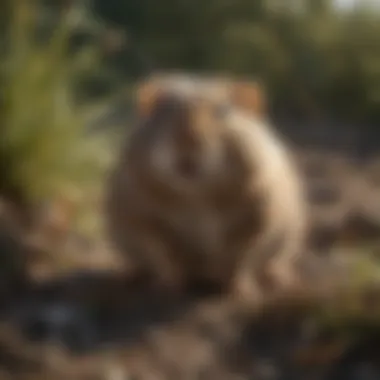

Proper Landscaping Practices
Proper landscaping practices can considerably limit the presence of voles in your yard. One significant aspect includes choosing plants that are less appealing to voles. For example, opting for native plants can often deter these rodents. Additionally, maintaining a dense and well-kept lawn can discourage voles as they prefer areas with less ground cover. This strategic choice is beneficial because it not only enhances your yard's aesthetic appeal but also contributes to the long-term reduction of rodent populations. A unique feature is that these practices are environmentally friendly, reducing chemical use and promoting biodiversity.
Maintaining Healthy Soil
Maintaining healthy soil is another essential element of cultural controls. Fertile soil promotes robust plant growth. Healthy plants can better withstand damage from pests like voles. A key characteristic of healthy soil is its organic matter content, which supports strong root systems. This approach is advantageous because it creates a resilient garden, naturally combating potential infestations. However, it requires consistent attention and may involve additional effort and knowledge about soil management practices.
Physical Barriers
Creating physical barriers is a practical technique in vole prevention. These barriers serve as a direct line of defense against potential invaders, effectively minimizing contact.
Fencing Options
Fencing options are an effective means of protecting your garden or yard against voles. A key characteristic of fencing is that it needs to be at least 12 inches high and buried 6 inches underground to prevent burrowing. Choosing materials like wire mesh provides durability and visibility. It is a popular choice for homeowners across various regions since it effectively combines functionality with an element of design. However, the installation can be time-consuming and may require ongoing maintenance to ensure the integrity of the structure.
Netting Strategies
Netting strategies can also be an effective means of exclusion for vulnerable plants. Netting can cover garden beds, providing a physical barrier against voles while allowing sunlight and moisture to reach plants. The key feature of netting is its lightweight design, making it easy to install and remove. This approach is beneficial because it provides immediate protection to seedlings during their vulnerable growth stages. Nonetheless, it may need frequent replacing if exposed to harsh weather conditions or if the netting becomes damaged.
Natural Deterrents
Natural deterrents encompass various substances and techniques that can help keep voles away without harmful chemicals. For example, the application of castor oil or planting herbs like mint can be effective in repelling these rodents. The advantage of natural deterrents is their safety for pets and children, aligning with the sensibilities of many homeowners. However, the effectiveness can vary, and consistent application may be necessary to maintain their protective quality.
"Preventive measures are generally more effective than reactive ones, and establishing a vole-unfriendly environment is crucial for long-term success."
Implementing these preventive measures will help establish a comprehensive strategy for managing vole populations in residential areas. By understanding the various elements and utilizing thoughtful practices, homeowners can protect their landscapes more effectively.
Methods for Vole Removal
The presence of voles in your yard can lead to significant damage to plants and roots. Understanding various methods for vole removal is essential for homeowners looking to protect their landscape. Different removal techniques offer their own advantages and challenges, from humane traps to chemical controls. Effectively removing voles requires a nuanced approach, considering both the immediate need to control the population and the long-term management of your yard.
Trapping Techniques
Types of Traps
Using traps is one of the most effective methods for controlling vole populations. There are several types of traps, including snap traps, live traps, and electronic traps. Snap traps are a popular choice, being efficient and easy to set up. They quickly kill the voles, reducing the chances of them scaring other animals. Live traps allow for humane capture, enabling release far from your property.
They have unique features that cater to different preferences of homeowners. Snap traps, for instance, are widely regarded for their simplicity. They are usually effective with minimal placement skills. However, they require caution during handling due to their lethal nature. On the other hand, live traps can be set without causing direct harm, but they necessitate diligent monitoring to prevent stress to the captured animals.
Setting Traps Effectively
The effectiveness of traps significantly depends on how well they are set. Identifying high-activity areas is crucial. These are places where voles frequently travel. Proper placement enhances the likelihood of capturing these rodents. The traps should be placed near runs or burrows to maximize success.
This aspect of trapping is critical as it emphasizes the importance of strategic planning. Setting traps effectively takes into account the voles' behavioral patterns. Misplaced traps often lead to frustration without any captures. Furthermore, using bait can improve results. Common baits include peanut butter and rolled oats, enticing voles to engage with the traps.
Chemical Control Options
Pesticide Guidelines
When dealing with voles, chemical control options can be considered, but they require strict adherence to pesticide guidelines. These guidelines ensure that the chemicals used are effective while minimizing harm to other wildlife and pets. Using the right products is crucial as not all pesticides target voles effectively.
The key characteristic of pesticides is their ability to disrupt the biological functions of voles when administered correctly. It is vital to follow manufacturer instructions for application rates and methods. Improper usage can lead to ineffective results or environmental harm. Some pesticides may have specific restrictions based on local regulations. Homeowners must research what is legal and safe for their area to avoid complications.
Safety Considerations
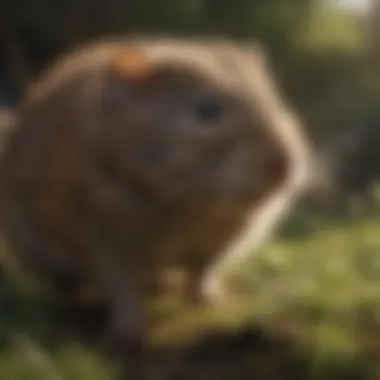
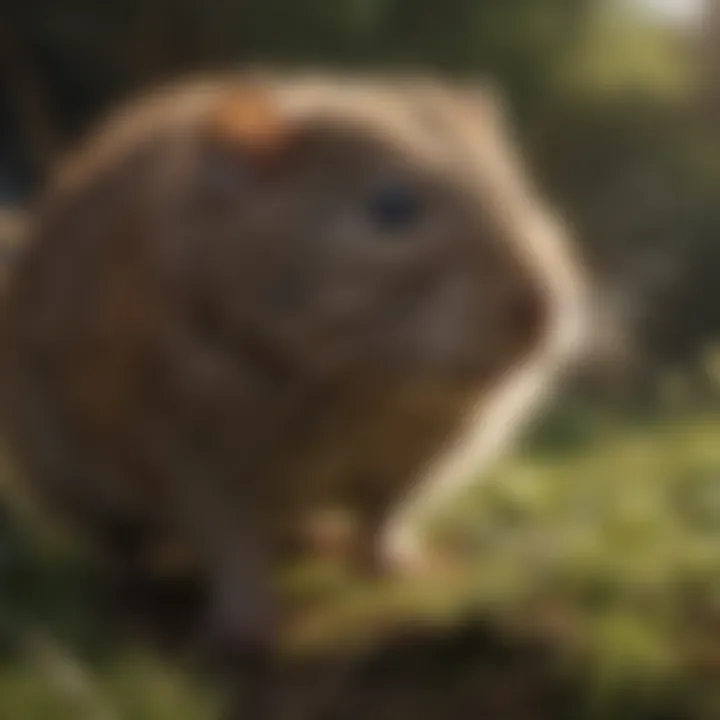
Safety precautions are paramount when using any chemical controls. Understanding how to store, handle, and apply pesticides determines the safety of both people and pets in the vicinity. Protective gear, such as gloves and masks, should be worn during application, reducing exposure risks.
The unique feature of safety considerations is ensuring that the products and methods used do not cause unintended consequences. Chemicals can have profound impacts on non-target species, including beneficial insects and animals. Homeowners must weigh the benefits of chemical control against the potential risks. Educating oneself on the active ingredients and any known side effects can provide clarity on the viability of using such methods.
Professional Extermination Services
When to Consider Professionals
In some scenarios, the vole problem may escalate beyond what can be managed through traps or chemicals. Homeowners might consider professional extermination services when facing large populations or when previous attempts have failed. These experts have specialized knowledge and equipment for dealing with extensive infestations.
The primary reason to consult professionals centers on their experience and access to advanced tools and products. They utilize techniques that might not be available to general consumers while ensuring that control measures align with local regulations. However, hiring professionals can be more costly, and it is wise to assess the scale of the issue beforehand.
What to Expect from Services
Engaging professional services often involves an initial consultation. During this visit, an inspector evaluates the yard for signs of voles and determines a strategy for elimination. Homeowners can expect systematic approaches, including traps and bait application tailored to their unique situations.
An important aspect of professional extermination is their commitment to follow-up. Many services provide reports and suggestions for preventing future infestations. This comprehensive service can be a significant advantage, ensuring that the management plan established will effectively protect the yard long-term. However, it is essential to verify credentials and read reviews to select reliable providers.
In summary, removing voles from your yard involves methods that are suited for both immediate and long-term management. Whether choosing trapping techniques, chemical controls, or professional help, each option offers unique benefits and considerations that can aid homeowners in safeguarding their landscapes.
Long-term Management Strategies
Long-term management of voles is crucial for maintaining a healthy yard. It is not enough to merely remove these rodents; proactive strategies help prevent their return. Effective long-term management involves two key aspects: environmental modifications and continuous vigilance. By implementing these strategies, homeowners can create a more inhospitable environment for voles, enhancing the health of their landscape.
Maintaining a Vole-Free Zone
Creating and maintaining a vole-free zone requires real attention to detail. First, it is important to manage vegetation. Tall grasses and dense shrubs provide shelter and food for voles. Regularly mowing grass, pruning shrubs, and avoiding ground cover that attracts voles can limit their habitat. Another key point is to keep garden areas clear of debris. Wood piles and unused tools can offer hiding spots. Regular cleanup in these areas makes them less appealing to voles.
Using specific plant selections also helps. Consider planting species that are less palatable to voles, such as lavender or daffodils. These plants can deter them from accessing your more vulnerable plants. Incorporating mulch can both suppress weed growth and reduce available hiding places.
Monitoring for Future Issues
Monitoring is essential to ensure that voles do not return. Regular inspection is necessary. Check for signs of vole activity, such as new tunneling or damage to plants. Early detection fosters timely action, which is always the best approach. It is also good practice to maintain clear records of any vole activity observed. This information helps identify patterns in their behavior, assisting in anticipating future issues.
An integrated pest management approach is advisable. This involves observing not just for voles, but all parts of the ecosystem. By understanding the connections within your yard, it’s possible to reduce overall pest populations and create a balanced environment.
Community Efforts in Vole Management
Community involvement can greatly enhance efforts to manage voles. When neighborhoods collaborate, their combined knowledge and resources often lead to more effective solutions. Creating local support groups can be beneficial. These groups may facilitate sharing of pest control advice, strategies, and resources.
Coordinated efforts could also involve organizing community cleanup days, where residents focus on eliminating potential vole habitats. Furthermore, educational workshops can inform residents about best practices to deter voles in their properties.
Engaging with local agricultural extensions or pest management professionals can provide valuable insights and assistance. They can help share effective management strategies that cater to specific regional issues.
Effective long-term management combines proactive strategies and community collaboration.
By following these long-term management strategies, homeowners can create a more sustainable and vole-resistant yard. Doing so not only minimizes the risk of future infestations but also enhances the overall health and beauty of the landscape. Regular upkeep, vigilance, and a commitment to community cooperation are essential in the fight against these persistent pests.
Closure
In this article, we examined crucial tactics for effectively managing voles in your yard. Understanding the significance of a proactive and informed approach stands as the backbone of successful rodent control. Voles can cause substantial damage to landscapes, including vegetation destruction and soil erosion. Acknowledging their habits and behaviors lays the groundwork for implementing effective strategies.
Recap of Key Points
To summarize the vital points discussed:
- Understanding Voles: Knowledge of vole species, their physical traits, and typical behaviors is essential for effective management.
- Identifying Infestation Signs: Recognizing signs like tunneling, plant damage, and droppings allows for timely intervention.
- Preventive Measures: Implementing cultural controls, physical barriers, and natural deterrents can significantly reduce vole populations.
- Methods for Removal: Utilizing traps and considering chemical control options must be executed with care, especially regarding safety and environmental impact.
- Long-term Management: Monitoring and community involvement are key in maintaining a vole-free landscape.
Final Thoughts on Vole Management
Managing voles is not merely about removal; it encompasses a broader strategy of preventing future infestations. Homeowners are encouraged to stay vigilant and adaptable. The combination of knowledge, proactive measures, and community support enhances the effectiveness of vole management. Education on this topic ultimately leads to healthier yards and gardens. By being informed and taking appropriate action, one can not only eliminate voles but also foster an environment that discourages their return.
"An ounce of prevention is worth a pound of cure."
This saying rings especially true when considering the challenges voles present. By adopting consistent practices and involving the community, you can achieve lasting solutions to protect your landscape from these persistent rodents.



